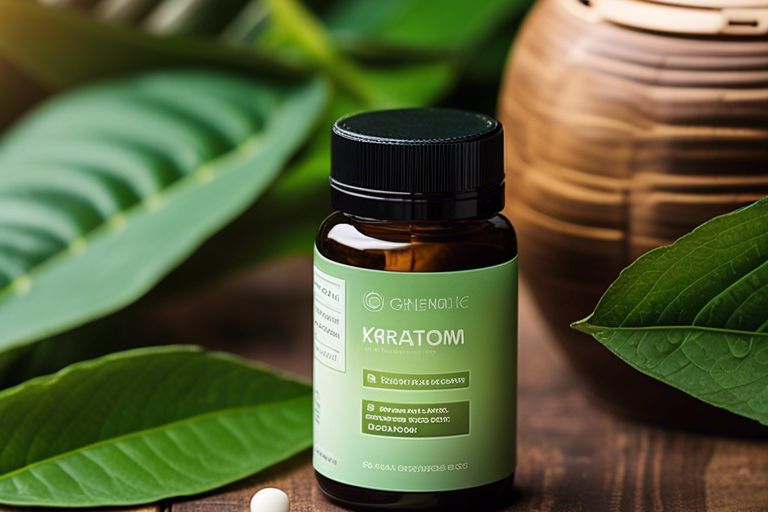Pain management is a critical aspect of healthcare, and while traditional medications have long been the go-to solution, an increasing number of individuals are seeking natural alternatives. One such alternative that has gained attention is kratom, derived from the powdered leaves of an Indonesian tree. Known for its opioid-like pain-relieving properties, kratom has garnered interest as a potential option for those seeking relief. However, its use is not without controversy, and questions remain regarding its safety and effectiveness. In this discussion, we will explore the potential benefits of kratom for pain management, examine its mechanisms of action, and consider the safety considerations associated with its use. By the end, you’ll have a better understanding of whether kratom could be a viable natural alternative for pain management.
Key Takeaways
- Kratom is derived from the leaves of the Mitragyna speciosa tree and has analgesic effects.
- Kratom contains active compounds that interact with opioid receptors in the brain, producing analgesic effects similar to opioids but with a lower risk of respiratory depression.
- Kratom may provide a natural alternative for pain management without the risk of respiratory depression or addiction.
- Consultation with a healthcare professional and obtaining kratom from reputable sources are essential for safe use.
Kratom’s Pain-Relieving Properties
Kratom exhibits pain-relieving properties through the presence of chemicals that mimic opioid pain relievers, making it a potential natural alternative for managing pain. Kratom, an herbal supplement derived from the leaves of the Mitragyna speciosa tree, has long been used by traditional medicine practitioners for its analgesic effects. This has led to an increased interest in studying its potential as a natural alternative for pain management, especially in light of the ongoing opioid crisis.
Research on kratom’s pain-relieving effects is still in its early stages, but preliminary findings are promising. The active compounds in kratom, such as mitragynine and 7-hydroxymitragynine, interact with opioid receptors in the brain, producing analgesic effects similar to those of opioids. However, unlike opioids, kratom compounds are believed to be safer in terms of respiratory depression, a potentially life-threatening side effect associated with strong opioids.
One study found that kratom behaved most similarly to buprenorphine, an opioid maintenance medication used for pain management and opioid addiction treatment. Buprenorphine is known for its ability to relieve pain without causing respiratory depression, making it a safer option compared to other opioids. The similarity between kratom and buprenorphine suggests that kratom may have similar pain-relieving properties without the risk of respiratory depression.
While many individuals use kratom for pain management, further research is needed to fully understand its effects and potential risks. It is important to note that kratom can have varying effects depending on the dosage and individual factors. Additionally, there have been reports of kratom use leading to dependence and withdrawal symptoms, further emphasizing the need for more research and regulation.
How Kratom Works in the Body
Through its interaction with certain pathways in the body, kratom produces its pain-relieving effects and exhibits similarities to opioid medications. Kratom, an herbal supplement, contains active chemicals that behave like opioid pain relievers. These chemicals, called alkaloids, are responsible for the analgesic properties of kratom. Kratom products are commonly consumed in powdered form as tea or in capsules.
Kratom compounds, such as mitragynine and 7-hydroxymitragynine, are partial agonists of the mu-opioid receptor. This means that their maximal effect is less than that of strong opioids like morphine or oxycodone. However, they still produce analgesia by binding to opioid receptors in the brain and spinal cord. By activating these receptors, kratom compounds can help relieve pain.
It is important to note that kratom can cause physical and psychological dependence, similar to other opioids. However, the risk of respiratory depression, a potentially life-threatening side effect associated with opioid use, is believed to be lower with kratom. This is because kratom compounds stimulate the G-protein-coupled pathway, which is associated with less respiratory depression compared to the beta-arrestin pathway activated by strong opioids.
While kratom has shown promise as a natural alternative for pain management, there is still limited research on its long-term use and safety. Studies comparing the safety and effectiveness of kratom to opioid maintenance medications, such as buprenorphine or methadone, are lacking. More research is needed to fully understand how kratom works in the body and its potential benefits and risks as a pain management option.
Potential Benefits of Using Kratom for Pain Management

Kratom, a natural herbal supplement, has shown potential benefits as an alternative for pain management. Research has indicated that kratom may provide relief for individuals suffering from chronic pain. Here are some potential benefits of using kratom for pain management:
- Pain relief: Many participants reported experiencing pain relief after using kratom. Kratom contains active compounds called alkaloids, such as mitragynine and 7-hydroxymitragynine, which interact with opioid receptors in the brain, potentially reducing pain sensation.
- Natural alternative: Kratom offers a natural alternative to traditional pain management methods, such as opioids. Unlike opioids, kratom does not carry the risk of respiratory depression or addiction. However, it is important to note that more research is needed to fully understand its safety and efficacy.
- Potential mood enhancement: Some users have reported improved mood and a sense of well-being after using kratom. This may be due to the interaction of kratom’s alkaloids with serotonin and dopamine receptors in the brain.
- Potential for decreased opioid use: Kratom has been explored as a potential tool for reducing opioid use in individuals with chronic pain. Some studies have shown that participants who used kratom were able to decrease their opioid dosage or completely stop opioid use.
It is essential to consult with a healthcare professional before using kratom for pain management, as individual experiences and dosage requirements may vary. Additionally, it is crucial to obtain kratom from reputable sources to ensure purity and minimize the risk of contaminants. While kratom shows promise as a natural alternative for pain management, more research is needed to fully understand its benefits and potential risks.
Safety Considerations When Using Kratom
When considering the use of kratom for pain management, it is crucial to be aware of important safety considerations. Kratom, a natural alternative and herbal supplement, has gained popularity for its potential benefits in managing pain. However, it is essential to understand the potential risks and side effects associated with its use.
Firstly, it is important to consult a healthcare professional before using kratom, especially if you are taking other medications. This is because kratom may interact with certain medications, leading to adverse effects or reducing their effectiveness.
Furthermore, it is essential to be aware of potential side effects that may arise from kratom use. These can include nausea, constipation, hallucinations, and liver damage. It is crucial to monitor your body’s response to kratom and discontinue use if any adverse reactions occur.
Additionally, it is advised to avoid combining kratom with alcohol or other drugs. This is because the combination can increase the risk of respiratory depression, which can be life-threatening.
Moreover, due to the lack of FDA approval and standardized dosing guidelines, it is important to carefully monitor and control your kratom intake. The potency of kratom products can vary, making it crucial to start with a low dose and gradually increase as needed. It is also important to stay updated on the legal status of kratom in your state, as regulations and restrictions may vary.
It is worth noting that while kratom has been associated with a number of deaths, it is often found in combination with other substances. The FDA and DEA have expressed concerns about kratom’s safety and have issued warnings about its use.
Is Kratom a Safe and Effective Option for Pain Management?
Kratom is known for its potential as a best kratom pain relief option, but its safety and effectiveness for pain management are still debated. While some people tout its benefits, others worry about its potential for addiction and adverse effects. More research is needed to determine its long-term efficacy and safety.
Are there other benefits of using Kratom beyond pain relief?
Yes, there are indeed different uses of kratom beyond pain relief. Some people use kratom for its energy-boosting properties, while others find it helpful for managing anxiety and stress. Additionally, some individuals use kratom to aid in relaxation and improve their overall mood.
How to Incorporate Kratom Into a Pain Management Routine

To effectively incorporate kratom into a pain management routine, it is crucial to understand the appropriate dosage and consumption methods while prioritizing safety and consultation with healthcare professionals. Kratom, a natural alternative for pain management, has been used as an herbal supplement to alleviate pain and reduce reliance on opioid medications. Here are four key considerations when incorporating kratom into your pain management routine:
- Start with a low dose: Begin with a dosage below 5 grams to assess its stimulant effects, which are similar to caffeine. This will allow you to gauge your body’s reaction to kratom and determine the appropriate dosage for pain relief.
- Gradually increase the dosage: If you experience positive effects and wish to pursue pain relief, gradually increase the dosage to 5-15 grams. However, it is essential to seek guidance from a healthcare professional who can provide personalized dosing recommendations based on your specific condition and needs.
- Choose a suitable consumption method: Kratom can be consumed as a tea or in capsule form. Opting for these methods can make it easier to incorporate kratom into your pain management routine, ensuring regular and consistent consumption.
- Monitor your body’s response: Pay close attention to any side effects or interactions with other medications when using kratom. It is important to be aware of any adverse reactions and consult with a healthcare professional if you experience any concerns.
Is Kratom a Safer and More Effective Alternative for Pain Management Compared to Coffee?
When it comes to pain management, the kratom vs coffee comparison may surprise you. While coffee can provide temporary relief, kratom offers a safer and more effective alternative. Kratom has been used for centuries to alleviate pain and its analgesic properties make it a popular choice for those seeking natural pain relief.
Frequently Asked Questions
Does Kratom Help With Severe Pain?
Kratom has been touted as a natural alternative for pain management, particularly for severe pain. It is believed that certain strains of kratom, when taken at the appropriate dosage, can provide relief for chronic pain, including neuropathic pain. However, it is important to note that the effectiveness of kratom for pain relief has not been extensively studied, and its long-term effects are still not well understood. Additionally, there are potential side effects and interactions with other medications that should be considered. Further research is needed to fully evaluate kratom’s role in pain management.
What Herb Is a Natural Painkiller?
There are several natural alternatives for pain management that have been used traditionally and have gained popularity in recent years. These include topical remedies such as creams and ointments, acupuncture, essential oils, meditation techniques, specific yoga poses, natural supplements, heat therapy, massage techniques, herbal teas, and mind-body techniques. While the effectiveness of these methods may vary from person to person, many individuals find relief from pain through these natural approaches. It is important to consult with a healthcare professional to determine the best approach for your specific condition.
Does Kratom Work as an Anti-Inflammatory?
Kratom has been suggested as a potential anti-inflammatory agent, but further research is needed to fully understand its effects. There is limited information available on the appropriate dosage of kratom for inflammation relief, and potential side effects and interactions with other drugs should be considered. Some strains of kratom may have anti-inflammatory properties, but more studies are required to confirm this. It is important to compare kratom with traditional anti-inflammatory medications and understand its mechanism of action in reducing inflammation. Additionally, caution should be exercised when using kratom to manage chronic inflammatory conditions, and user experiences and testimonials should be considered alongside scientific evidence. Precautions and warnings should also be taken into account when using kratom for inflammation.
What Leaf Is Good for Pain?
When considering the best strains for pain relief, red vein kratom has been found to be effective. Proper dosage of kratom is essential for pain management, as different strains have varying effects. Kratom tea can be a natural alternative for pain relief, and kratom capsules are commonly used for chronic pain. Additionally, kratom has shown potential for managing pain associated with conditions such as arthritis, neuropathy, post-surgical recovery, and menstrual cramps. It is important to consult with a healthcare professional before using kratom for pain relief.









